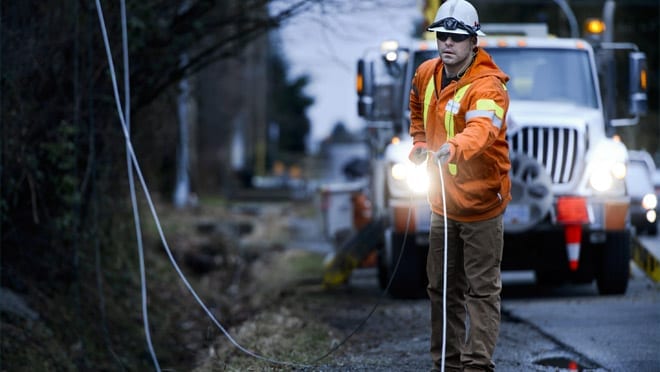“Storm season” is upon us, and that means an increased likelihood of power outages.
Waiting for the power to come back on in the dark can feel like an eternity, especially if you don’t know what’s happening. So BC Hydro have provided some tips and answers about how they restore power.
1. Stay back at least 10 metres from a power line on the ground
A damaged power line that’s still live with electricity will not necessarily be sparking, smoking or even making a buzzing sound. Always assume a fallen power line is live. Stay back at least 10 metres (about the length of a bus), keep anyone else in the area away, and call 911. A fallen power line is an emergency.
2. Safety determines priority of restoration of power
BC Hydro work to repair any issues that present an immediate danger to health and safety. From there, it’s a matter of getting the most customers back on as possible, as quickly and safely as they can.
- That often means repairing high-voltage transmission lines and substations. Transmission lines, unlike the distribution lines in your neighbourhood or on your street, serve large numbers of customers. Damage to a transmission line or substation equipment can affect tens of thousands of people, instead of a few hundred.
- Next, they will work with municipalities and emergency responders to get power back to critical services, such as hospitals, fire stations, and municipal water systems.
- Outages affecting a large neighbourhood are restored before smaller neighbourhoods, and finally, outages affecting individual customers or small pockets of five customers or fewer. That can mean that “newer” outages that affect much larger numbers of people may get tackled before an “older” outage in a smaller neighbourhood.
3. They don’t know about trees or branches on the lines until you tell them
You are asked to call 1 888 POWERON on a corded landline, or *49376 on your mobile device if you have key information that will help crews. If you can see a tree down on power lines, a branch on the lines, if you saw a bright flash or have any other information, give them a call.
4. If you can’t see them, it doesn’t mean they’re not working on the problem
Distribution lines from local substations are often located a distance from your home. A tree down four or five blocks away could be causing your outage.
If your power is out due to a problem on a transmission line or at a substation, it can be several kilometres away. Just because you haven’t seen any trucks or crews in your area doesn’t mean that they’re not working on your problem.
Sometimes you will also see crews arrive, and then leave – they usually can’t determine the extent of the damage or the repairs that are required until they arrive on site. They may need different equipment to make repairs, or they may determine that the source of the problem is in another area.
If crews leave, chances are they are still working on getting power back. Watch for updates at bchydro.com/outages – as crews report in about the damage. You can also see estimates of when power is expected to be back on.
5. When surrounding areas have power and you don’t
We may call it the electricity “grid”, but distribution circuits and feeders from substations aren’t laid out in a perfect square. So while most outages caused by storm damage can affect entire blocks or streets, there are times when your neighbours or the next street over are served by a different line or feeder. That can sometimes mean that you may have power and your neighbours don’t – or vice versa.
You can check the outage map to see the latest status for your power outage. Search by your address to find it on the map or select the red dot closest to your home to see the outage area. Estimated restoration times will be posted once crews have arrived and assessed the damage.
6. Getting the lights back on can sometimes mean turning them off again
In some areas, BC Hydro are able to switch customers to another circuit temporarily to start providing power again while crews work. It makes outages shorter and gets the lights back on while equipment is fixed or replaced.
But to complete the switching process, they sometimes need to take a short outage to ensure that crews can work safely. For you, this might look like your power coming back, only to go out again shortly after.
7. Putting power lines underground can’t eliminate power outages
Outages during storm season are mostly caused by fallen trees, so it’s reasonable to think that we could prevent most outages by simply putting power lines underground. But the truth is that there are thousands upon thousands of kilometres of power lines to serve homes and businesses in B.C., and putting them all underground would be difficult and hugely expensive.
Underground power lines are typically much more difficult to locate, access, and repair. This usually means longer outages, which can affect more customers than a single overhead line.
Specialized vegetation experts and partners in the municipalities work to proactively identify trees at risk of falling onto lines – known as hazard trees. BC Hydro also regularly maintain and prune trees around their equipment.
One of the best things to do when it comes to preventing power outages from trees is to plant the right tree in the right place.
Prepare for an outage, just in case
Winter weather is unpredictable, so you should always be prepared in case of an outage. Be sure to keep an emergency kit on hand.



